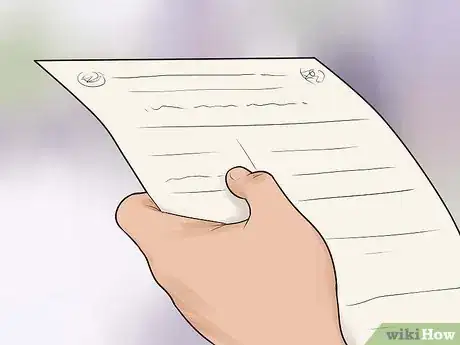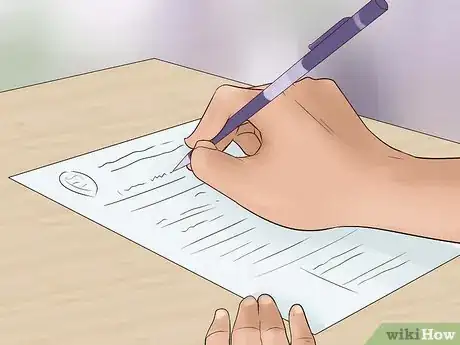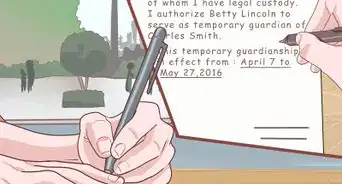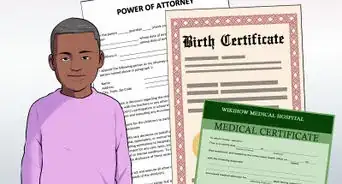This article was co-authored by Clinton M. Sandvick, JD, PhD. Clinton M. Sandvick worked as a civil litigator in California for over 7 years. He received his JD from the University of Wisconsin-Madison in 1998 and his PhD in American History from the University of Oregon in 2013.
There are 10 references cited in this article, which can be found at the bottom of the page.
This article has been viewed 102,795 times.
A custody order is a determination by a court that provides the rules on how parents who have been divorced or separated can exercise legal and physical custody of their children and exercise the right to visit the children.[1] Legal custody gives one or both parents the right to make decisions regarding the child’s welfare, education, medical care, religious instruction and other long-term decisions related to raising the child.[2] Physical custody gives one or both parents the right and responsibility to provide physical care and supervision to the child.[3] For the parent who does not have physical custody, the custody order provides the right to visit the children through visitation rights.[4] If your former spouse violates the terms of the custody order issued by a court with respect to your children, you have a number of options of enforcing the order. Common violations of custody orders include not respecting visitation rights, taking the child without informing the other parent, trying to alienate the child from the other parent, and not abiding by express terms of the custody order.[5]
Steps
Enforcing a Custody Order in Your Home State
-
1Keep a copy of the court order in a secure place.[6] This is very important. This should be a certified copy issued by the court. In any dispute about child custody, it is very important to have evidence of your legal rights and responsibilities regarding child custody, and the court order provides the best and legally authoritative evidence of those rights and responsibilities.[7]
-
2Review the order. If you are in the early stages of a child custody dispute, review the details of the order to see what your rights and responsibilities are according to that order. This is important because you may think that your former partner is violating the child custody agreement, but that may not necessarily be the case. Review carefully the details of the order to determine if the other party is in violation of the order.Advertisement
-
3Begin by sending a letter to your former spouse. It may be a good idea to begin with soft methods of enforcement rather than going straight to the authorities. This way, your dispute regarding the custody order can be resolved amicably and with little emotional disturbance to your children. An example of a soft method of enforcement is to send a written notice to the parent in violation of the order requesting him to comply with the order. You may use the help of a family law attorney to help you with the letter. Use formal language when writing the letter and include in the letter the following information:
- That you plan to exercise your rights under the order (e.g. by visiting the children at a specified time and location).
- That you plan to exercise your responsibilities under the order (e.g. by returning the kids at a specified time as required by the order).
- That continued violation of the order could result in a contempt of court action being filed against the non-complying parent (i.e. the parent in violation of the order).
-
4Contact the police to help you enforce the order. You may feel that the nature of the violation is such that you need the help of law enforcement to help you enforce the order. In this case, calling the police is an option.
- Note that although police enforcement of a custody order is a possibility in theory, in practice your local law enforcement may be unwilling to become involved in a family dispute unless the violation of the order involves criminal infractions (e.g. abuse or kidnapping).[8]
- The police may be willing to get involved in such cases that require calling the non-complying parent or escorting you to the non-complying parent’s house to pick up your kids.[9]
- Alternatively, the police may be unwilling to get involved if the infraction is not criminal in nature and may ask you to take the matter up with a court.[10]
-
5File an action for contempt. If writing a letter or having the police involved does not work, you may consider asking the courts to enforce the order through an action for contempt. In a contempt action, you ask a court to enforce the order. The court may determine whether the other parent willfully violated the order. Such a determination can have serious consequences for the non-complying parent.[11]
- The burden of proof lies with you. In other words, it is up to you to prove with solid evidence that the non-complying parent willfully violated the custody order. “Willfully” violating the order means the non-complying parent knew about the existence of the order, was able to comply with the order but knowingly violated the order, and does not have a just cause or excuse for violating the order.[12]
- An action for contempt requires filing a motion in the same court that issued the custody order. Filing a motion will result in the court issuing a hearing date. If you are using the help of an attorney, she can help you file the motion. If you are representing yourself, contact the court clerk for information on filing documents and procedures.[13]
- The non-complying parent has a right to be officially informed of the motion and pending charges against him. Therefore, after the court issues a hearing, you must serve the paperwork to the non-complying parent.[14] Your attorney can help you with this process.
- At the hearing, the judge will hear evidence from you (the party alleging that the order has been violated) and the non-complying parent. After hearing evidence, the judge will determine whether or not the non-complying parent willfully violated the order and, therefore, whether or not the non-complying parent is in contempt. If the judge finds the necessary proof, the court will issue an order detailing how the non-complying parent must comply and how the issue may be resolved.[15]
- Notice that the purpose of a contempt action is not to “punish” the non-complying parent but to pressure him into complying with the custody order. Avoid trying to use this method for resolving minor disputes, as a finding of contempt can lead to serious consequences for the non-complying parent. These consequences include civil and criminal charges, such as fines, paying your attorney fees, compensatory custody time, or even a consequence as serious as jail time.[16]
Enforcing an Out of State Custody Order
-
1Know your rights regarding enforcement across state lines. If you or your former spouse have relocated to a different state since your custody order was made, it is necessary to know the rules regarding the enforcement of custody orders across state lines.
- Currently, the Uniform Child Custody Jurisdiction and Enforcement Act (UCCJEA) governs the enforcement of “foreign” (i.e. out-of-state) custody orders.[17]
- The UCCJEA is a “uniform act”, which means it is a model act proposed by the National Conference of Commissioners on Uniform State Laws,[18] a non-governmental organization that publishes model acts that promote legal uniformity across the various jurisdictions in the United States. A model act needs to be adopted by the states for it to become enforceable in that state.
- As of February 2015, the UCCJEA has been adopted in 49 U.S. states, the District of Columbia, the U.S. Virgin Islands, and Guam. Puerto Rico rejected a proposal to adopt the act whereas Massachusetts remains 1 of the 50 states that has not adopted the act yet, although a bill has been introduced in Massachusetts to adopt the act.
-
2Consider registering your out-of-state custody order. If you have an out-of-state custody order, consider registering the order in your current state of residence. The UCCJEA establishes a procedure for registering your out of state custody order. Registering your order is not required but doing so can be beneficial for a number of reasons, which include the following:
- By registering, you put the courts in your current state of residence on notice regarding your custody order.[19]
- By registering, you are in effect testing whether your order is enforceable in the future. Registering gives you the assurance that the order will be enforceable in the future if necessary.[20]
- By registering, you limit the possible defenses to enforcement that may exist. This means that if you need to enforce the order some time in the future, you can do so without delays.[21]
- By registering the order, you may reduce or eliminate the need for a lawyer, which can save you money.[22]
- By registering the order, you make the order (as of the date of registration) enforceable as if it were an in-state custody order.[23]
-
3Register the order. If you do decide to register your custody order in your new state of residence, you must send a request for registration in a court in the new state. You will provide, as documentation for that request, the custody order and other required information. That court will then file the order and will “serve notice” (i.e. formally inform) on the other parent about the registration. The other parent has 20 days to request a hearing to contest the validity of the order, and if the other parent does not contest, the order becomes enforceable as if it were a local (i.e. in-state) custody order.[24]
-
4Seek expedited enforcement if necessary. The UCCJEA creates a fast-track enforcement mechanism in those cases in which your objective is to regain physical custody of your child immediately. If the other parent presents a risk to your child of physical harm or abduction, this expedited remedy can be used. A warrant will be issued to allow you to take physical custody of the child. This will occur after a hearing that will take place as soon as possible (i.e. the same day or the next day) and the warrant will be issued unless the other parent has a valid defense.[25]
-
5Inform police if your child is in danger of being kidnapped. The UCCJEA includes enforcement provisions designed to prevent one of the parents from kidnapping the child. If you worry that your child is imminently likely to suffer serious physical harm or is about to be physically taken away from the state by the other parent, you can file a petition for what is known as a “pickup” order.[26]
- The court takes testimony (by phone or in person by you or another witness). If the court finds that the child is imminently likely to suffer serious harm or be removed from the state, the court will issue a warrant directing law enforcement personnel to take physical custody of the child.[27]
- The other parent will be served with the petition, warrant, and order at the time the police is picking up the child, and there will be an opportunity for a hearing to take place as early as the next day if possible.[28]
References
- ↑ https://www.cga.ct.gov/current/pub/chap_815p.htm#sec_46b-115a
- ↑ http://family.findlaw.com/child-custody/legal-custody.html
- ↑ http://family.findlaw.com/child-custody/legal-custody.html
- ↑ https://www.cga.ct.gov/current/pub/chap_815p.htm#sec_46b-115a
- ↑ http://www.attorneys.com/child-custody/what-constitutes-a-violation-of-a-custody-agreement/
- ↑ http://www.courts.ca.gov/1188.htm
- ↑ http://www.courts.ca.gov/1188.htm
- ↑ http://dadsdivorce.com/articles/violating-child-custody-orders-should-you-call-the-police/
- ↑ http://dadsdivorce.com/articles/violating-child-custody-orders-should-you-call-the-police/
- ↑ http://dadsdivorce.com/articles/violating-child-custody-orders-should-you-call-the-police/
- ↑ http://www.courts.ca.gov/1188.htm
- ↑ http://mensdivorce.com/contempt-actions-enforcing-court-orders/
- ↑ http://mensdivorce.com/contempt-actions-enforcing-court-orders/
- ↑ http://mensdivorce.com/contempt-actions-enforcing-court-orders/
- ↑ http://mensdivorce.com/contempt-actions-enforcing-court-orders/
- ↑ http://mensdivorce.com/contempt-actions-enforcing-court-orders/
- ↑ https://www.law.cornell.edu/wex/uniform_child_custody_jurisdiction_and_enforcement_act_uccjea
- ↑ http://www.uniformlaws.org
- ↑ https://www.ncjrs.gov/html/ojjdp/jjbul2001_12_2/page6.html
- ↑ https://www.ncjrs.gov/html/ojjdp/jjbul2001_12_2/page6.html
- ↑ https://www.ncjrs.gov/html/ojjdp/jjbul2001_12_2/page6.html
- ↑ https://www.ncjrs.gov/html/ojjdp/jjbul2001_12_2/page6.html
- ↑ https://www.ncjrs.gov/html/ojjdp/jjbul2001_12_2/page6.html
- ↑ https://www.ncjrs.gov/html/ojjdp/jjbul2001_12_2/page6.html#sixty-four
- ↑ https://www.ncjrs.gov/html/ojjdp/jjbul2001_12_2/page6.html#sixty-four
- ↑ https://www.ncjrs.gov/html/ojjdp/jjbul2001_12_2/page6.html#sixty-four
- ↑ https://www.ncjrs.gov/html/ojjdp/jjbul2001_12_2/page6.html#sixty-four
- ↑ https://www.ncjrs.gov/html/ojjdp/jjbul2001_12_2/page6.html#sixty-four






































































